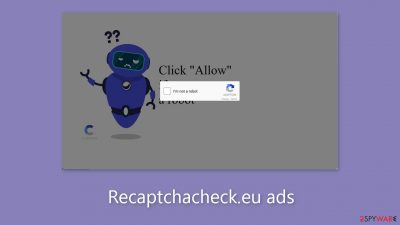Recaptchacheck.eu ads (spam) - Free Instructions
Recaptchacheck.eu ads Removal Guide
What is Recaptchacheck.eu ads?
Recaptchacheck.eu is a bogus site that was created by crooks to generate revenue passively

Recaptchacheck.eu is a fraudulent website that uses deceptive tactics to trick users into subscribing to push notifications. It dupes users into clicking the “Allow” button, ostensibly to verify they are human, but instead bombards them with intrusive pop-up advertisements that persist even after the browser is closed.
To make matters worse, these pop-ups may come from rogue advertising networks[1] that direct users to dangerous websites. Individuals are thus exposed to fraudulent platforms that seek to extract personal information, coerce them into downloading potentially unwanted programs (PUPs),[2] or even infect their systems with malware.
Numerous reports have surfaced regarding the appearance of advertisements promoting bogus antivirus software, software deals, bogus giveaways, surveys, and other deceptive schemes. It is critical to disable these pop-ups, especially if multiple users use the affected device, as they may lead to more severe infections. Our comprehensive guide contains detailed instructions.
| NAME | Recaptchacheck.eu |
| TYPE | Push notification spam; adware |
| SYMPTOMS | Pop-up ads start appearing in the corner of the screen unexpectedly, sometimes even when the browser is closed |
| DISTRIBUTION | Shady websites; deceptive ads; freeware installations |
| DANGERS | The pop-ups can contain links leading to websites from rogue advertising networks |
| ELIMINATION | Go to your browser settings to disable website permissions |
| FURTHER STEPS | Use FortectIntego to fix any remaining damage and clear your browsers |
Distribution methods
In search results, we rarely come across sites like Recaptchacheck.eu. They typically lurk on unregulated and dubious websites. Illegal streaming platforms,[3] for example, are notorious for hosting deceptive advertisements, hidden redirects, and fake “Download” and “Play” buttons that open new tabs containing harmful content.
It is strongly advised that you limit your visits to websites that you are familiar with and trust. Choose legitimate streaming services such as Netflix or Hulu, which pose no risks. Clicking on random links and advertisements, even if they appear to promote legitimate products or services, should be avoided. It is preferable to go directly to the source website.
Another possibility is that the deceptive page appeared on its own, with no user interaction. This can happen if you have adware on your device. Adware, such as pop-ups, banners, and redirects, can generate an excessive amount of commercial content. It frequently infiltrates systems via freeware installations.

Freeware installations
The most common way for people to inadvertently infect their devices with adware is by installing programs from freeware distribution platforms. These platforms frequently include additional applications in their installers, disguised as ostensibly useful tools. Many users rush through the installation process, missing these bundled extras.
It is critical to always use the “Custom” or “Advanced” installation methods and to carefully read the Privacy Policy and Terms of Service. The most important step is to inspect the file list thoroughly and deselect any checkboxes associated with unrelated applications. When installing software, it is strongly advised to use only official web stores and developer websites to ensure the safety of your device.
How to disable push notifications?
Below you will find a manual guide on how to take care of your browser. Because push notifications are subscription-based, you will have to disable them yourself:
Google Chrome (desktop):
- Open Google Chrome browser and go to Menu > Settings.
- Scroll down and click on Advanced.
- Locate the Privacy and security section and pick Site Settings > Notifications.
![Stop notifications on Chrome PC 1 Stop notifications on Chrome PC 1]()
- Look at the Allow section and look for a suspicious URL.
- Click the three vertical dots next to it and pick Block. This should remove unwanted notifications from Google Chrome.
![Stop notifications on Chrome PC 2 Stop notifications on Chrome PC 2]()
Google Chrome (Android):
- Open Google Chrome and tap on Settings (three vertical dots).
- Select Notifications.
- Scroll down to Sites section.
- Locate the unwanted URL and toggle the button to the left (Off setting).
![Stop notifications on Chrome Android Stop notifications on Chrome Android]()
Mozilla Firefox:
- Open Mozilla Firefox and go to Menu > Options.
- Click on Privacy & Security section.
- Under Permissions, you should be able to see Notifications. Click Settings button next to it.
![Stop notifications on Mozilla Firefox 1 Stop notifications on Mozilla Firefox 1]()
- In the Settings – Notification Permissions window, click on the drop-down menu by the URL in question.
- Select Block and then click on Save Changes. This should remove unwanted notifications from Mozilla Firefox.
![Stop notifications on Mozilla Firefox 2 Stop notifications on Mozilla Firefox 2]()
Safari:
- Click on Safari > Preferences…
- Go to Websites tab and, under General, select Notifications.
- Select the web address in question, click the drop-down menu and select Deny.
![Stop notifications on Safari Stop notifications on Safari]()
MS Edge:
- Open Microsoft Edge, and click the Settings and more button (three horizontal dots) at the top-right of the window.
- Select Settings and then go to Advanced.
- Under Website permissions, pick Manage permissions and select the URL in question.
![Stop notifications on Edge 1 Stop notifications on Edge 1]()
- Toggle the switch to the left to turn notifications off on Microsoft Edge.
MS Edge (Chromium):
- Open Microsoft Edge, and go to Settings.
- Select Site permissions.
- Go to Notifications on the right.
- Under Allow, you will find the unwanted entry.
- Click on More actions and select Block.
![Stop notifications on Edge Chromium Stop notifications on Edge Chromium]()
Cookies and cache
If you successfully blocked ads using your browser settings, you must now take additional precautions by clearing your browser's cookies and cache. Almost every website uses these elements to track your online activities. They can save information like your IP address, geolocation, visited websites, and online purchases.
This data could be sold to advertising networks or other third parties, which is why security experts recommend clearing your browser's data on a regular basis. We offer an automated solution called FortectIntego if you prefer to avoid a lengthy manual process. This powerful software not only clears your browser data, but it also fixes system errors, repairs corrupted files, and resolves registry issues. This feature is especially useful after a virus infection.
Remove adware from your system
If you have followed the aforementioned steps but continue to encounter unwanted symptoms such as an excessive presence of commercial content, pop-ups, banners, and redirects, it is advisable to investigate the possibility of an adware infection on your system.
Since it may be challenging to pinpoint which specific application is causing the issues, we recommend utilizing reliable anti-malware tools like SpyHunter 5Combo Cleaner or Malwarebytes. These software solutions can automatically scan your machine and thoroughly eliminate any adware infections. Additionally, security software can provide proactive warnings before any malicious programs can make unauthorized changes.
However, if you prefer to tackle the issue manually, below are the instructions for Windows and macOS systems:
Windows 10/8:
- Enter Control Panel into Windows search box and hit Enter or click on the search result.
- Under Programs, select Uninstall a program.
![Uninstall from Windows 1 Uninstall from Windows 1]()
- From the list, find the entry of the suspicious program.
- Right-click on the application and select Uninstall.
- If User Account Control shows up, click Yes.
- Wait till uninstallation process is complete and click OK.
![Uninstall from Windows 2 Uninstall from Windows 2]()
Windows 7/XP:
- Click on Windows Start > Control Panel located on the right pane (if you are Windows XP user, click on Add/Remove Programs).
- In Control Panel, select Programs > Uninstall a program.
![Uninstall from Windows 7/XP Uninstall from Windows 7/XP]()
- Pick the unwanted application by clicking on it once.
- At the top, click Uninstall/Change.
- In the confirmation prompt, pick Yes.
- Click OK once the removal process is finished.
Mac:
- From the menu bar, select Go > Applications.
- In the Applications folder, look for all related entries.
- Click on the app and drag it to Trash (or right-click and pick Move to Trash)
![Uninstall from Mac 1 Uninstall from Mac 1]()
To entirely remove an unwanted app, you need to access Application Support, LaunchAgents, and LaunchDaemons folders and delete relevant files:
- Select Go > Go to Folder.
- Enter /Library/Application Support and click Go or press Enter.
- In the Application Support folder, look for any suspicious entries and then delete them.
- Now enter /Library/LaunchAgents and /Library/LaunchDaemons folders the same way and terminate all the related .plist files.
![Uninstall from Mac 2 Uninstall from Mac 2]()
How to prevent from getting adware
Stream videos without limitations, no matter where you are
There are multiple parties that could find out almost anything about you by checking your online activity. While this is highly unlikely, advertisers and tech companies are constantly tracking you online. The first step to privacy should be a secure browser that focuses on tracker reduction to a minimum.
Even if you employ a secure browser, you will not be able to access websites that are restricted due to local government laws or other reasons. In other words, you may not be able to stream Disney+ or US-based Netflix in some countries. To bypass these restrictions, you can employ a powerful Private Internet Access VPN, which provides dedicated servers for torrenting and streaming, not slowing you down in the process.
Data backups are important – recover your lost files
Ransomware is one of the biggest threats to personal data. Once it is executed on a machine, it launches a sophisticated encryption algorithm that locks all your files, although it does not destroy them. The most common misconception is that anti-malware software can return files to their previous states. This is not true, however, and data remains locked after the malicious payload is deleted.
While regular data backups are the only secure method to recover your files after a ransomware attack, tools such as Data Recovery Pro can also be effective and restore at least some of your lost data.
- ^ Zeljka Zorz. How does a rogue ad network function?. Helpnetsecurity. Information Security Blog.
- ^ Chris Hoffman. PUPs Explained: What is a “Potentially Unwanted Program”?. Howtogeek. Technology Magazine.
- ^ Brittni Devlin. Why Should You Avoid Illegal Streaming Sites?. Makeuseof. Security Blog.













